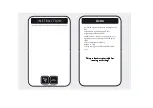
S&C Instruction Sheet 695-505
25
Appendix A
Routine Switchgear Testing
For the convenience of users who normally perform
electrical tests on system components such as switchgear,
appropriate withstand test values for Vista SD Underground
Distribution Switchgear are given in the following tables.
These test values are significantly greater than the normal
operating voltage of the switchgear and are near the
flashover voltage of the switchgear. They should be applied
only when the switchgear is completely de-energized and
disconnected from all power sources.
WARNING
When performing electrical withstand tests on Vista
SD Underground Distribution Switchgear, always
observe the following precautions.
Failure to observe
these precautions can result in a flashover, injury,
and equipment damage.
1. Completely de-energize the switchgear and
disconnect it from all power sources.
2. Terminate bushings with an insulated cap or other
appropriate cable termination capable of withstanding
the test voltage.
①
The power-frequency withstand test voltages listed in the table are
approximately 80% of the design values for new equipment.
②
The dc withstand test voltages listed in the table are approximately
80% of the design values for new equipment.
③
Dc withstand test voltages are given for reference for those users
performing dc withstand tests. The presence of these values does not
imply a dc withstand rating or performance requirements for the switch-
gear. A dc withstand design test is specified for new equipment because
the switchgear may be subjected to dc test voltage when connected to
the cable. The dc withstand test voltages listed in the table are approxi-
mately equal to the ac test voltage.
Dc Cable Testing and Fault Locating
Dc testing of installed cables is performed to determine
the condition of the cables and to locate faults. Industry
standards such as IEEE 400, “IEEE Guide for Making
High-Direct-Voltage Tests on Power Cable Systems in the
Field,” describe such testing and should be referenced for
selection of the test procedures. Dc testing also includes
cable “thumping” (the sudden application of dc voltage
from a large capacitor for the purpose of fault locating),
which causes transients and voltage doubling at the end
of the open cable. When the cables are attached to the
switchgear, the unit will also be subjected to the dc test
voltages.
WARNING
The dc withstand capability of the switchgear may
be reduced because of aging, damage, or electrical
or mechanical wear. Therefore, the dc test voltage
must be selected so it does not exceed the withstand
limits of the switchgear.
Application of dc test volt-
age greater than the withstand capability of the
switchgear can result in a flashover, injury, and
equipment damage.
DANGER
Do not exceed the test voltages given in Table 4 on page
26. Exceeding the test voltages can cause a flashover
of the isolating gap or phase-to-phase insulation of
the switchgear.
This can lead to a power-frequency
fault in the gear of the dc test source, and result in
severe personal injury of death.
Table 3. Maximum Insulation Test Voltages
Vista SD Switchgear Rating, kV
Withstand Test Voltage, kV
IEC
IEEE
Impulse (BIL)
Power Frequency
①
Dc
②③
12
17.5
95
31
42
24
29
125
45
62



































